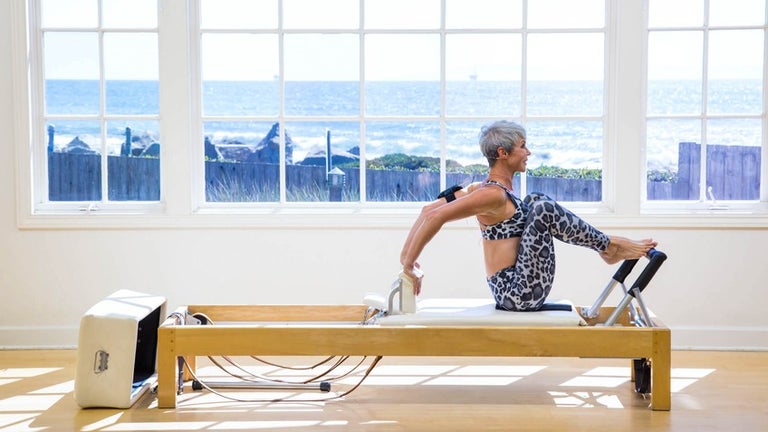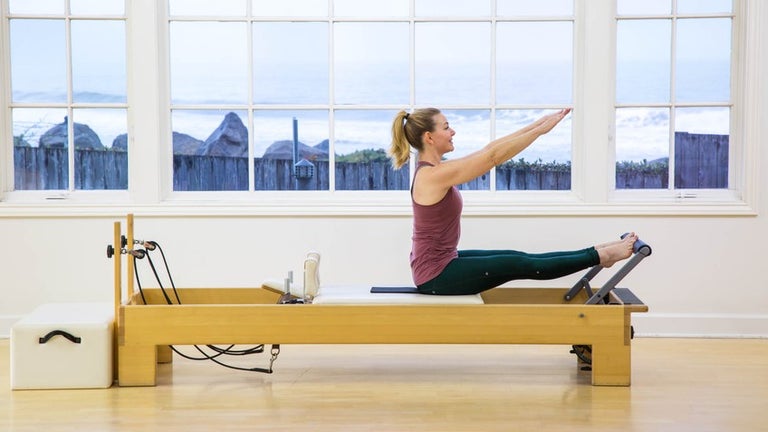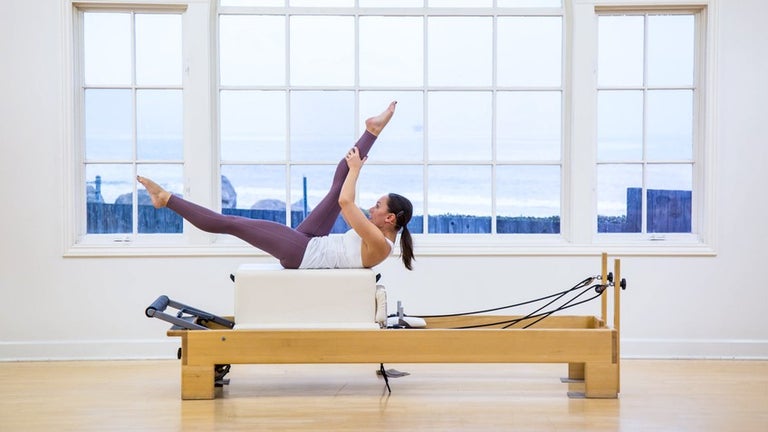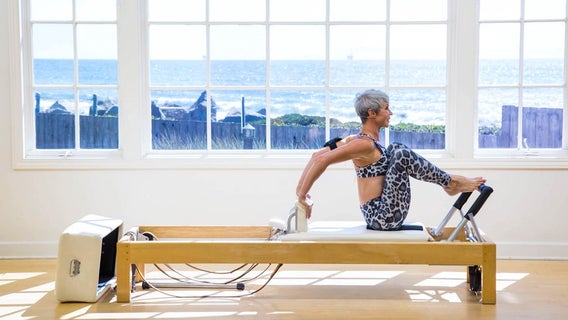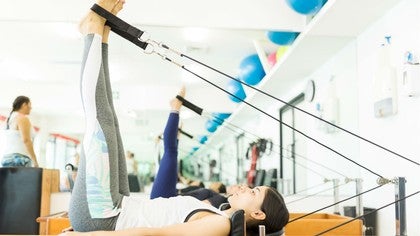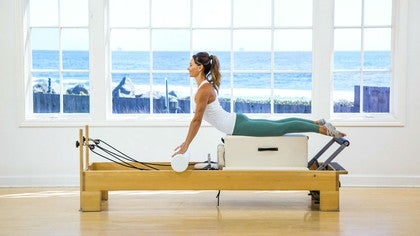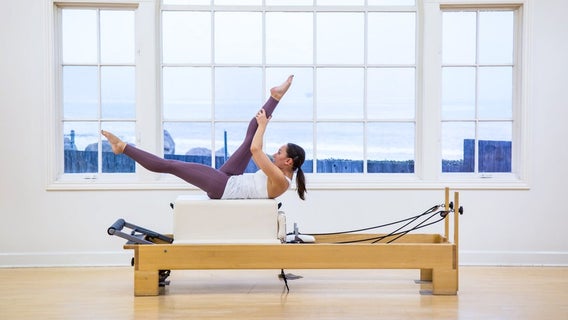Reformer Pilates for Beginners

What is a Reformer?
The Reformer is one of the best known and most used pieces of Pilates Apparatus (equipment). Joseph Pilates designed and built the first Reformers and used a Reformer in his studio until his death in 1967. The Reformer is used to assist Pilates students in the exercises. It consists of a platform bed on a frame (generally 7 feet in length and about 2.5 feet wide), a set of risers with pulleys and ropes attached, a footbed, and a sliding carriage which attaches to the springs and gear system. The carriage also has a headrest and shoulder blocks. The springs allow for heavy or light resistance.
The Reformer is great for beginners
A Reformer adds another layer to beginner Mat Pilates exercises. In addition to the ability to challenge the body with heavy or light resistance, controlling the movement of the carriage offers an added challenge. The student is "driving" the carriage versus "riding" it and must control speed and flow. The spring system, foot bar, and straps provide feedback to the body and additional challenges. As the student becomes stronger, lighter springs can be used to make the exercises more challenging. Both beginner and experienced students benefit from the assistance the Reformer gives in maintaining alignment during the Pilates exercises.
Some Tips Before you Start with a Reformer
Beginners should always familiarize themselves with all parts of the Reformer before getting on it. Hands and feet should remain out of the spring area. Initially, heavier spring weight will allow you to have better control and stay safe, especially when getting on and off. But the resistance should not be so great that it feels like weight lifting or straining. Pilates exercises begin and are centered on the core (your body versus your arms or legs), so if it feels like you are getting a leg or arm workout, your springs may be too heavy. Taking a private Reformer Pilates class from a trained Pilates teacher or a few classes in a Pilates studio are great ways to learn to use the Reformer and become comfortable with beginner Pilates. Videos like those offered on Pilates Anytime are also helpful to study first and then use while on your Reformer.
Reformer Exercises for Beginners
To view the full class, start your free trial now and get access to over 800 Reformer Pilates classes!
Beginner mistakes to avoid on the Reformer
Like all Pilates students on Apparatus or the Mat, a beginner to the Reformer should focus on awareness, breath, and control. Often, beginners use too many springs or too heavy spring weight, and race through the exercises. Don’t forget that you must first stabilize and engage your core before moving. Move as slowly as you need to in order to maintain control. And although Pilates is also about flow, beginners often fall into the trap of continuous movement.
Reformer modifications for beginners
Beginners should focus on their ability to safely practice each exercise on the Reformer. Kneeling versus standing, bent knees versus straight legs, and using a smaller range of motion are all good options when starting out. You may also skip work that feels too challenging. Small pelvic tilts can be as effective as a full bridge at any stage of your Pilates practice! In addition, the parts of the Reformer are all adjustable to fit your size and needs. The footbar has multiple positions depending on your flexibility. The shoulder rests are also often adjustable for the width of your shoulders and placement of your body on the carriage. The headrest can be adjusted to an angle to help support your neck. Make sure you are comfortable before you begin.
Featured Reformer Classes
We have over 800 Reformer Pilates classes to begin and grow your Pilates practice.
Beginners ready to progress
Most Pilates workouts are 40 minutes to an hour in length. It may take several months of twice a week classes to become strong enough to move from beginner to intermediate work. Once you are comfortable doing the beginner Reformer exercises, you will be ready to move up a level. You will know you are ready when you can maintain a slow and steady pace, control your movement and stabilize your body even when your legs and arms are moving. Remember that the most advanced Pilates practitioner often uses the beginner exercises within each session, adding more advanced exercises to the mix for new challenges. Think of a figure skater in the Olympics or a gymnast starting out. They must perfect the basic moves before they can add on more difficult tricks. Each basic move is a building block for something more challenging. The same is true for Pilates!
Some advice for intermediate classes
Don't be in a rush to advance to the next set of exercises. Pilates is a practice, and you are never done learning about your body or building your strength or flexibility. If you find yourself getting bored, allow your focus to hone in on muscles that you haven't used in other types of exercise and movement work. Learning to listen to your body is one of the critical skills to gain before you progress. But also, don't be afraid of trying the next challenge. Pilates is designed to support you as you grow in balance, coordination, fluidity of movement, and the ability to use your powerful body efficiently and with intention. And sometimes we learn just as much from what we are not yet able to do as from those things that have begun to come easily. Pilates is hard and sometimes frustrating but it's a whole lot of fun!
Reformer Pilates Frequently Asked Questions
Is the AeroPilates reformer a good alternative for home?
An AeroPilates Reformer is a version of a "home" Reformer on the market today. It uses a cord system versus springs for resistance. This Reformer is sturdy enough for all Pilates exercises and although the cords may feel lighter than the spring system, it easily adapts to exercises done in the Pilates studio. It is a viable entry-level Reformer to supplement your classes at the Pilates studio. The AeroPilates Reformer is made of a lighter weight material than a Studio Reformer. It comes in pieces, so prepare to put it together yourself like a piece of Ikea furniture. It does not come with a box, but one can be purchased. The AeroPilates Reformer is not quite the same dimensions as a Studio Reformer or as sturdy, but it is quite safe and allows you to practice Pilates at home.
Is the Reformer safe for people with back pain?
Many people with back pain are told by their doctors and physical therapists that Pilates will help them. Often beginners and seniors are hesitant to try Reformer Pilates if they have a history of back pain. Reformer work is an excellent entry to Pilates for someone with back pain because the Reformer can help support the body within the exercises as strength and flexibility increases. The Reformer is also harder to "cheat" on than Mat Pilates. This means you won't compensate for weakness in the areas you need to strengthen with muscles you already overuse. Those with any back pain or history of back issues should begin their Pilates program with a teacher versus at home alone. Choosing a Pilates studio instead of a group class at the local gym is also wise as they are only teaching Pilates and will be able to keep you safe and help you build your strength and flexibility.
How to find a good teacher?
One of the best ways to learn Pilates is with a good teacher. This is even truer when learning to use the Reformer and choosing to practice Reformer Pilates. Initially, you may want to search for Pilates studios in your town. Remember that Pilates teachers will have initially taken at least 450 hours of training on the Mat and Apparatus, including Reformer training. Call your local studio and ask questions. Look at the teachers' profiles online and read about their experience and even their interests or philosophy to find someone who feels like a good fit. Many teachers will speak with you or allow you to watch a class to see if you are comfortable with their teaching style. Ask friends and colleagues if they know a good Reformer teacher, look for teachers in your area via the Pilates Method Alliance website, or check out the apparatus manufacturers for a list of teachers in each state. Most importantly, make sure you feel comfortable with whoever you choose. And if for some reason you don't feel like your first choice is a good fit, communicate with them and ask them to help you find the right teacher for you. Pilates teachers love Pilates and want you to find a teacher who will help you love it too.
How to deal with soreness?
A great beginner Pilates Reformer program should include a regular schedule. A beginner should practice on the Reformer two or three times weekly. When you begin practicing Pilates on the Reformer, you are likely to feel some new muscle soreness even if you are an active person. Be sure to continue to stretch in between workouts. Getting on the floor and practicing some of your Mat Pilates stretches, exploring reaching and lengthening with arms and legs, and moving your body in all the ways you can think of will help relieve some of the soreness. Going for a brisk walk, taking a hot shower, or even soaking in the tub will all relieve your sore muscles. Pay attention to what your body feels like when you are walking, sitting down, standing up, getting out of bed, even bending over to tie your shoes, or washing your hair in the shower. If you feel sore in new ways doing each of those things, pay attention to which muscles you feel in each activity. This is a great way to gain more body awareness! Feeling your lower abdominal muscles when you walk after a Reformer workout, or your butt or abdominals when you sit or stand up will help you understand how to use those muscles in your everyday activities.
Join Our Online Community
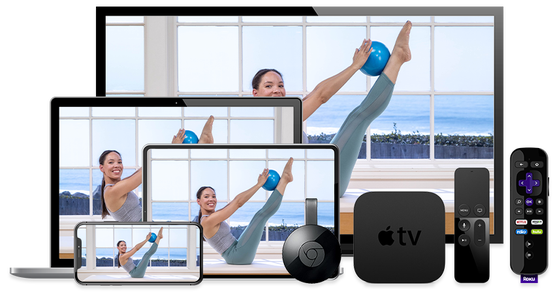
- 15-Day Free Trial
- Unlimited Access to Thousands of Classes
- 95+ Pilates Programs and Challenges
- No Ads
- New Videos Weekly
- Available on All Your Favorite Devices
